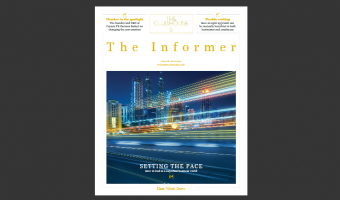News from in & around
The Clubhouse
Superfast: How Pace-Setting Drives Performance
How do great leaders in business today deal with this superfast world and prepare their companies to be fit for the future, asks Sophie Devonshire, CEO of the Caffeine Partnership.

The world is changing fast. We all know this. Everyone talks about constant disruption in business and everyone expects technology to continue to drive rapid change for your clients/ customers/consumers and for your people. Companies are growing at phenomenal rates and they are disappearing fast as well. Looking at the FTSE 100 from the 1980s, we can see that only 28 of the original remain. Bigger companies can still fail. Newer companies are taking power faster than ever; ‘unicorns’ can win their billion-dollar valuations within a year or two of coming into being and can decimate industries that took many decades to build. With other start-ups, it’s a tougher tale – 50 per cent of SMEs in the UK fail to celebrate their fifth birthday.
The fast pace of technological change has driven customer expectations, the responsiveness of businesses and their ability to scale. But what do you do about this knowledge that change and challenges abound? How do great leaders in business today deal with this superfast world in a way which makes it enjoyable and not exhausting? How do they handle the pace with grace? How do they prepare their organisations (and themselves) to be fast and fit for the future world?
These are some of the questions I’ve explored in my recent bestselling book Superfast: Lead at Speed in which I outline a variety of tips, tools and techniques to help leaders work out how to set the right pace in a fast-moving world, based on research amongst over 100 global leaders.
Great leaders are pace-setters. How do you, as a leader, set the right pace? Leaders are sometimes nervous of, or prone to, moving so fast that they can alienate their teams. But if they move too slowly, they can lose their relevance in a constantly shifting world and they can frustrate the ambitious in their teams and among their investors and customers. In today’s highly competitive global environment, caution is safer in the short term but can be highly dangerous in the long term. Finding ways to keep our pace competitive to meet the demands of the short-term and protect against the challenges of the long-term is essential. Setting the right pace in business is a labyrinthine leadership challenge, mainly because it involves humans (fallible, emotional, complex beasts) – humans who buy or buy into your business offer; humans who work for you; and you, yourself, a wonderfully complex human.
Pace-setting requires technological and human understanding. The pace of acceleration that people are focusing on is being driven by technology (and will continue to feature artificial intelligence as a key component) but the ability to steer through with anthropoid intelligence remains fundamental. And that starts with an awareness of your role as a leader, as a pace-setter.
The increased rapidity of change in our world has led to vulnerabilities both political and economic, but I am encouraged by the equally rapid growth in business leaders who are interested in being not just responsive but also responsible – those looking to create purpose and a positive world.
In fact, rather than just thinking about speed, it’s more effective to question your ‘velocity’. Velocity is speed in a given direction; the right direction. Leadership is about setting that direction – working out where purpose and vision channel the right speed, and managing a varied pace for your business which must work out when to slow down to think, and how to be set up to move fast to seize the opportunities before your competitors do. It’s an exciting world, full of opportunities but we need to get the pace right. Think slowly, act fast.
Sophie Devonshire is CEO of the Caffeine Partnership and will be hosting an energising breakfast with practical tips and thought-provoking discussion on how to lead at speed in a superfast world at The Clubhouse, Holborn Circus on the 27 June at 8am. Superfast: Lead at Speed is available from Amazon.
This article was originally featured in The Informer – June 2019. To read the full magazine please click here


